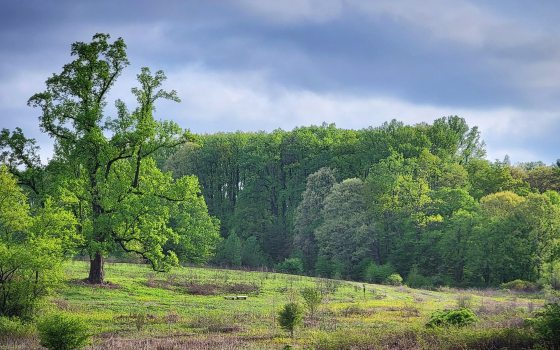What is your favorite tree? It’s a time-honored question that will evoke answers from even the most taciturn individual. Even if they don’t know any details about its history or type, their face will be transformed as they provide their answer, often accompanied by a story or a memory—reaffirming the reverent nature we share for trees. At Longwood, we have countless tree experts on staff: from tree care authorities, to specialists on specific genera or species, to those who work tirelessly on the storied endeavor of bonsai. Many members of our team have dedicated their professional life to trees and can spout off Latin names at the drop of a hat or can easily recall the backstory of how a tree arrived here—even a century-old tree that far predates their lifetime. Here, follow along as we ask them, of our nearly 10,000 trees here at Longwood, “What is your favorite tree?” … and enjoy their stories.
Kristina Aguilar, Associate Director, Plant Information and Mapping
Kristina Aguilar oversees the meticulous organization required of our living collections—including knowing which plant is where in the Gardens at all times. Her favorite? The Franklin tree (Franklinia alatamaha), found in a grove in front of the Pierce-du Pont House.
The Franklin tree is an example of how our plants have a purpose, and the importance of living collections. Philadelphia Quaker botanists (the Bartram Brothers) visited Georgia and collected seeds from this tree around the time of our country’s founding. In fact, the tree itself is named after Benjamin Franklin. After the Revolutionary War, the brothers returned, trying to find the species again—but it was gone. There are many theories that are associated with its extinction, but the point remains: If this species was not in cultivation and grown in gardens, it would cease to exist.
“What I personally like about the Franklin tree is its showy characteristics and multi-seasonal beauty in the garden,” shares Aguilar. “As an ornamental horticulturist, I am drawn to plants that offer more than one season of interest in the garden. The Franklin tree and its relatives (genus Stewartia) both have a stunning flower display of cup-like white flowers with vibrant egg-yolk yellow centers, and wonderful, scarlet fall color.”

“The later bloom season of the Franklin tree also is welcomed when many other trees have stopped flowering,” shares Aguilar. Photo by Candie Ward.
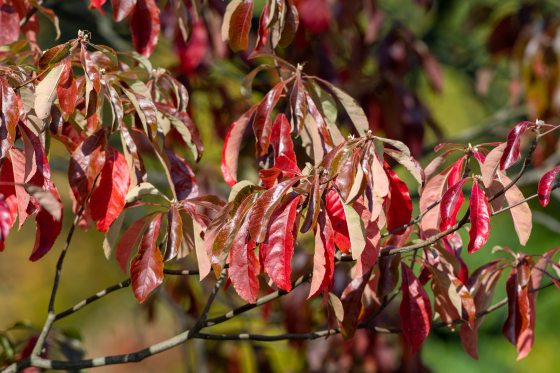
The fall color of the Franklin tree is striking in autumn. Photo by Hank Davis.
”Longwood’s grove of Franklinia (mixed accessions from 1976 and 1983) northwest of the Peirce-du Pont House contain some of the largest specimens in the state of Pennsylvania. These trees represent an important tie to Longwood’s early history when the Quaker Peirce family had Franklinia growing on this land in the 1820s. Through records and herbarium specimens this tree is a link to our past.”
Zachary Jacobs, Arborist
As an arborist, Zachary Jacobs has more than a passing admiration for trees. A typical “day at the office” for him is being suspended high above the ground in the branches of a tree, working tirelessly to ensure that our trees are well-managed and stay healthy. His favorite: Pollarded littleleaf linden (Tilia cordata).
Jacobs explains: “Some of my favorite trees at Longwood are the pollarded lindens that comprise the Italian Water Garden. The Italian Water Garden is a very unique landscape, and the framing of these trees in this traditional pruning style makes it extra special. This task is something that the arborists undertake every year, but when the job is done, the sense of satisfaction is palpable.”
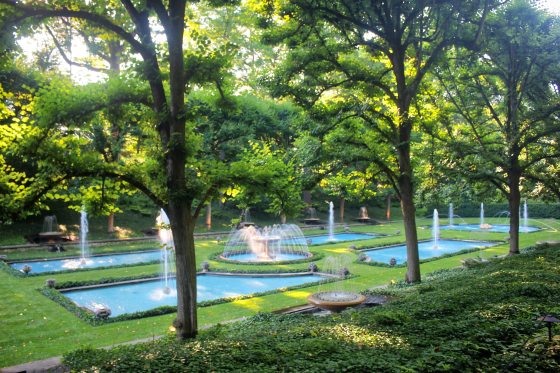
Littleleaf lindens delight along the Italian Water Garden. Photo by Scott Hummel.
Pollarding, done since medieval times— though not often seen state-side—is a special technique done to maintain trees at a certain height and promote healthy growth. During the winter months, their artfully manicured limbs add a sculptural element to the experience of being in the garden.
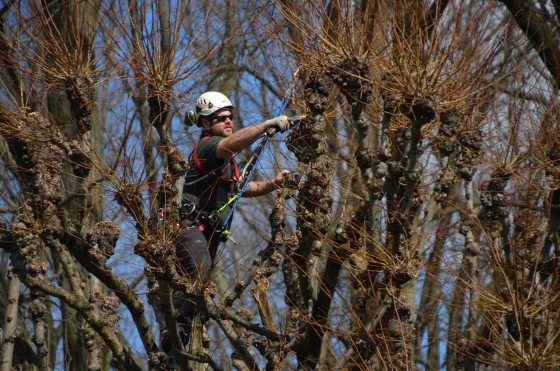
Associate Director, Grounds Tyler Altenburger prunes the littleleaf lindens in the Italian Water Garden. Photo by Amy Simon Berg.
As a tree, lindens have flowers that attract local pollinators like hummingbirds, butterflies, and other insects. In the summer, they provide dappled shade, and in the fall, linden leaves have a luminous light golden-yellow hue, often with hints of warm amber and tawny edges. You can also find this tree in a non-pollarded form, creating allées in the Main Fountain Garden.
Colvin Randall, P.S. du Pont Fellow
An institution in his own right, Colvin Randall is an author and authority on Longwood’s legacy. His story in the garden began in 1973; since then, he’s spoken frequently about Longwood Gardens, including its history, magnificent garden features, the evolution of its bucolic landscape, and the performing arts. (One) of his favorite trees? The Visitor Center American elm (Ulmus americana).
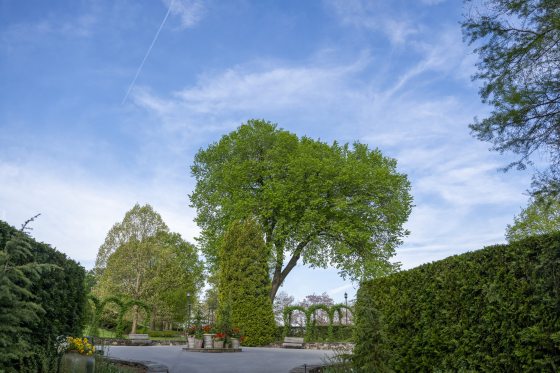
This American elm, planted sometime in the early 1930s, survived the spread of the Dutch Elm Disease, and now is an approximate 90-foot-tall behemoth. Photo by Hank Davis.
“A favorite [of mine] has been the remaining American elm at the Visitor Center,” shares Randall, along with a photo he took of the tree in 1967. “At that time, it was the tree on the right and the whole south walkway was sheltered by an American elm tunnel, which was extraordinary—see the 1987 photo (one tree already gone on the right side). The tree that remains today is no less extraordinary as a single specimen. This tree is notable for its size in relation to its location at the entrance to the Gardens. Aside from the aspects of its age and 'survivor story', its grand scale is what makes the experience iconic within the Gardens. It provides a sense of place as soon as you enter.”

The American elm, as pictured on the right in this 1967 photo. Photo by Colvin Randall.

The south side of the Cow Lot originally featured an allée of American elms, as shown in this 1987 photo. Photo by Colvin Randall.
Kate Santos, Associate Vice President, Science
As Associate Vice President of Science at Longwood Gardens, Kate and her team are entrusted to lead our science-based activities, strategically driving excellence in research, conservation, land stewardship, and ecology with local, national, and global impact. She is a trained botanist with professional horticulture experiences ranging from academic and commercial research to strategy development and operations. Her favorite: The tulip-tree (Liriodendron tulipfera) in the Meadow Garden, as shown in the first image of this blog post, photographed by Santos.
“Solitary trees represent living, architectural constants in seasonally changing landscapes, their presence anchoring our sense of place and our connection to it. The tulip-tree in the Meadow Garden is a wonderful example of this. This solitary sentinel stands in the center of the Meadow Garden, the inflection point between its past and future, guiding guests along their way to the Webb Farmhouse and back towards the garden. Capturing how the meadow and the tree transform with the seasons is a passion of mine, I love to watch how the tree complements the changes occurring around it while also preserving the holistic integrity of the meadow system in both space and time.”

Towering on the right side of this photo, the tulip-tree looks to the Webb Farmhouse. Photo by Kate Santos.
Santos further explains: “The tulip-tree is native to Pennsylvania and a member of the Magnolia family with beautiful flowers that dot its towering canopies. These trees grow to be some of our tallest native trees on the east coast and if you have chance to walk amongst a forest of them, like in our Forest Walk, you will quickly see how high into the sky these trees can climb and the beautiful canopy cathedral created for us to walk or sit beneath, providing us space for refuge, reflection and respite.”
Matt Turner, Bonsai Grower
As a bonsai grower, Matt Turner meticulously shapes miniature trees through pruning, wiring, and root care, crafting them into living art that mirrors nature’s beauty. This delicate practice requires continuous training and assessment to maintain tree form, structure, and health. This job requires years of dedication to horticulture, artistry, and technique. Turner excels in honoring the passage of time, skillfully training even young specimens to evoke the presence of ancient trees. His favorite? The pomegranate (Punica granatum) bonsai, displayed seasonally in our Bonsai Courtyard.
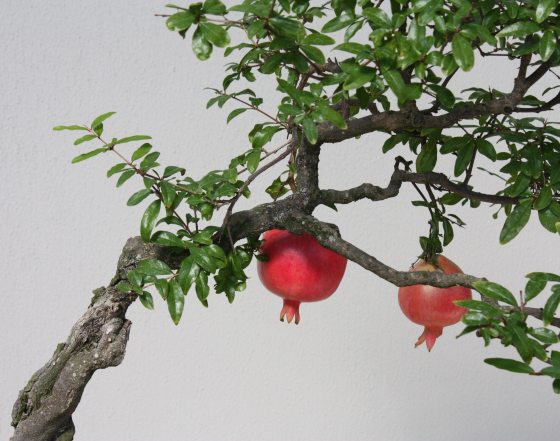
Pomegranates naturally have a twist in their trunks, which add visual interest. Photo by Pat Quattrone.
As Turner shares, “Pomegranates work so well because they fit many of the guidelines and patterns we strive for in bonsai, including interesting deadwood features that enhance the appearance of age, but simultaneously remind us that some ‘rules’ can be broken. The flowers and fruit on most species do not reduce in size with training like we can often achieve on leaf size. When our pomegranate bonsai flower and fruit, those are much larger and not to scale of the miniaturized tree.”
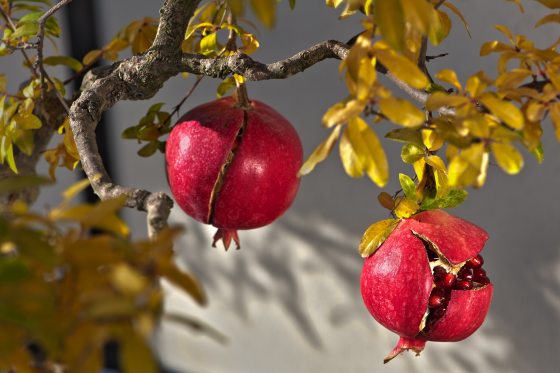
A close view of full-sized pomegranate fruit on our bonsai. Photo by William Hill.
Turner continues: “The changes throughout various seasons also makes this an interesting subject throughout the year. Shiny, vibrant new leaves in the spring emerge with a flush of reddish orange before fully opening and hardening off to green. In late spring to early summer flowering begins. When our smaller tree is healthy enough to support fruit, we hand-pollinate flowers with a paintbrush to encourage fruit to set. If successful, the fruits grow all season before ripening to a bright red in the fall as the leaves change to yellow.”
Chris Cole, Vice President, Horticulture
Chris Cole leads Longwood’s Horticulture Department, advancing our commitment to the art and science of horticulture, while creating innovative seasonal displays, gardens, and landscapes, and furthering scientific research and land stewardship practices. With more than 30 years of international horticultural experience at both public and private gardens, Cole has held senior positions in the UK and Australia, and has extensive experience spearheading comprehensive conservation and ecological planning projects, including the establishment of the Climate Change Alliance of Botanic Gardens, a global coalition of more than 500 member gardens dedicated to addressing climate change’s impact on managed landscapes.
His favorite tree—or trees—at Longwood? The grove of 100-year-old London plane-trees (Platanus × hispanica) just outside of the West Conservatory. Dating back to the early 20th century and planted by our founder, Pierre S. du Pont, these trees stand as living testaments to the enduring legacy and forward-thinking vision that define Longwood Gardens.
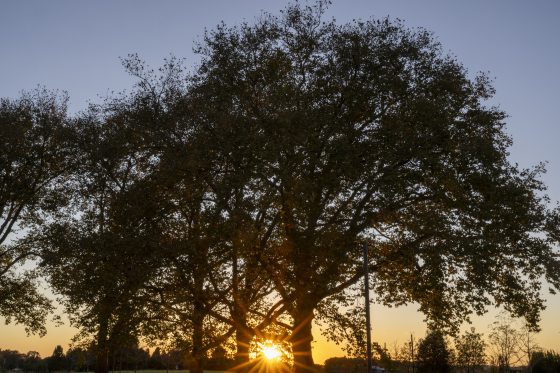
The sturdy trunks and leafy canopy of our grove of hundred-year-old London-plane trees are echoed in the architectural design of the nearby West Conservatory. Photo by Hank Davis.
“The magnificent grove of eight London-plane trees has a wonderful presence in the landscape proving complementary scale, grandeur, and balance to the new West Conservatory,” he shares. The trees create an elevated landmark and punctuation to the west of the formal gardens while offering year-round interest with their generous canopy in summer, color in fall, and stunning mottled bark and silhouette in winter. This tough species, often planted in urban areas, has provided a thread of continuity in all the cities I’ve been fortunate to practice horticulture in, including London, Sydney, Melbourne, and now Philadelphia.”
Patrick Joyce, Nursery Manager
Patrick Joyce manages our seven-acre woody nursery, which supports all of our seasonal and permanent woody plants, as well as our Specimen Tree Replacement Plan, through which Longwood preserves the germplasm of certain trees—those dating back to the 1800s, state champion trees, and those valuable to the aesthetic landscape of the Gardens. His favorite? Threadleaf Japanese Maple (Acer palmatum 'Ornatum').
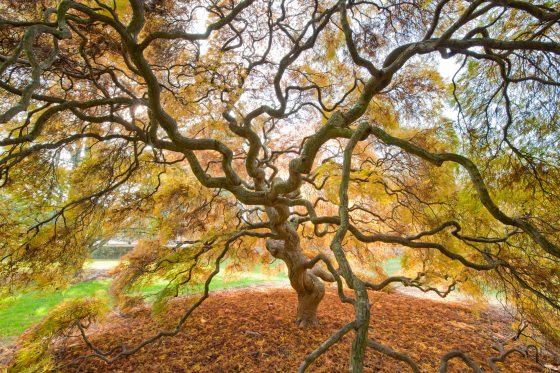
Our Threadleaf Japanese Maple in Oak and Conifer Knoll, pictured here in its autumn glory. Photo by William Hill.
Tucked away in the Hillside Garden, there stands a Threadleaf Japanese Maple, a second place PA champion tree for cut leaf Japanese maples, and it was acquired by Mr. du Pont prior to 1954. It’s been growing in the southern area of Oak and Conifer Knoll since at least the early 1980s.
As a cultivar, it is propagated by cuttings and grafting and is a recipient of the prestigious “Award of Garden Merit” by the Royal Horticultural Society. Architecturally, this plant is fascinating, with an unusual shape and strong pendulous form.
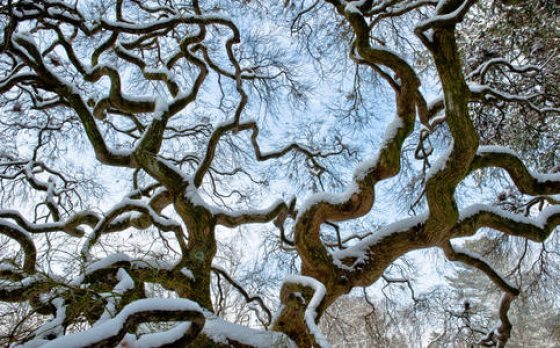
The winter months highlight the interesting form and lines of the Threadleaf Japanese Maple.
“You can just tell the amount of work that went into growing it,” shares Joyce. “As a tree, it is meant to be short in stature, and essentially, be a weeping form. Someone spent time training it, supporting it, helping it grow upright … they essentially turned it into a living sculpture. Not only that, but like many Japanese Maples, it has spectacular fall color and slender leaves that provide excellent texture and is just a great addition to the space.”
Jessica Turner-Skoff, Associate Director, Science Communications
Like many plant people, my typical answer to a question like this is “it depends on the day.” I find a new favorite during every stroll. However, time and time again, my heart gets pulled to the call of one special species that has an incredible story: the Ginkgo (Ginkgo biloba).
The ginkgo is a survivor. A resilient tree, its fossil records indicate it is slightly older than 200 million years. To put this in perspective, it is older than the stegosaurus. As a common street tree, it is known for its ability to thrive in conditions that would hinder or hurt others. In juxtaposition, however, in the wild it is endangered due to loss of habitat. With a unique form, trees that are either male or female, and saffron-yellow fan-shaped leaves that tend to drop all at the same time, it is a curiosity and a work of art.

To Turner-Skoff, “Being around ginkgo trees conjure up happy memories from my time living near a grove of ginkgo in downtown Chicago. Frequently, the residents of the area would collect its seeds along the sidewalk to eat, while further down, my kids and I would play in a pile of their sunny leaves as they rained down from a crisp, blue sky above.” Photo by Cathy Matos.
While it is a storied species, our own ginkgo near the Peirce-du Pont House is one that has an additional layer of heritage. It is estimated to be around 200 years old. The color, unique leaves and structure add to the rich historical tapestry of this significant space.
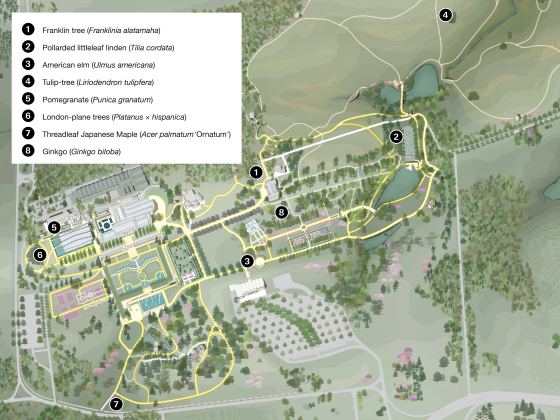
Experience this selection of favorite trees in-person during your next visit to the Gardens; their locations can be found on this map.
Editor’s note: Join us online for our June 25 Science Series: From Miniature Masterpieces to Majestic Giants: Trees at Longwood Gardens. During this online talk, celebrate and explore the remarkable world of trees and their care along with a team of Longwood experts specializing in stewardship, bonsai, management, and more. Our panelists highlight the extraordinary variety of trees on our grounds, share insights into the importance of curated collections and natural areas, and tell their stories about this important form of life. This Science Series talk is fully online; registration is required .
